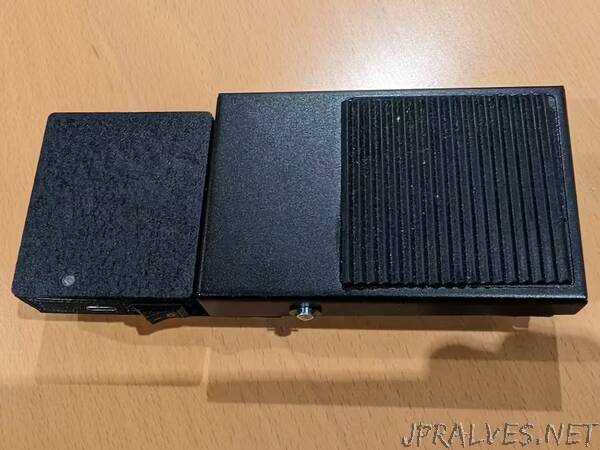
“Wireless page turner designed for use with piano music apps such as Forscore on a tablet. Can be battery or USB powered.
How It Came About
My brother is a keen and accomplished piano player (I’m keen too but rubbish at playing). He uses Forscore on his Apple iPad to keep all his music score sheets in one place. The app is very good but as with all sheet music, and especially music displayed on a tablet, turning to the next page can interrupt ones playing.
This project was designed to create a foot switch page turner linked to the iPad but without wires. Such page turners can be purchased commercially but what is the fun in that?
So the requirements were:
1) A robust foot switch
2) No power cables (implying battery powered)
3) No interface cables to the iPad (implying wireless signalling)
4) As compact as possible
5) Low cost!
Although designed for music score page turning on an iPad, there is no reason why this cannot be used for turning pages for book apps etc. on the tablet.
The switch could probably be adapted for people with disabilities too.
Hardware Design
I selected the Seeed Xiao nrRF-52840 for this project as this module is very compact, supports BLE (Bluetooth low energy), has low sleep currents and supports LIPO battery charging. This then minimised the rest of the circuit to the actual pedal switch, the LIPO battery and an on/off switch to isolate the battery.
A metal foot switch was chosen, available from Ebay, which was low cost and robust however being metal, I was concerned that his could potentially screen the bluetooth transmissions so I designed a 3D printed case to attach to the underside and back of the foot switch. The case is fixed to the underside of the foot switch using the screws holding the rubber feet. The case therefore ‘floats’ at the back of the foot switch but is firmly attached. The gap between the two allows for the slight rotation of the rear of the pedal when pressed.
The on/off switch fits into one side of the case. The Xiao nRF-52840’s USB connection is also made available through the side of the case. This can be used to power the unit and recharge the battery.
Note: the on/off switch must be in the ‘on’ position to charge the battery.
Should the battery be completely omitted, then the unit can just be powered via 5v on the USB connector however this will of course require a permanent powered connection when in use.
The Xiao’s on board LEDs are in a position where they are close to the USB connector and wouldn’t be seen with the lid on so the lid has a ‘collar’ built into it to take a short length of light pipe down to the LEDs. This is a little complicated so an alternative would be to not fit the light pipe or make a hole through the side of the case to make the LEDs visible from the side.
The clip on lid also has 3 stand offs. 2 of these ensure the battery is held firmly in position via some thin rubber padding and the other stand off ensures the Xiao is held in place as there are no fixing holes on the Xiao PCB itself.
The internals of the case have been designed to support the Xiao off the floor of the case and supporting the back of the Xiao so that it doesn’t move when a USB cable is plugged in yet is easily removable if needed. There is also a divider for the battery compartment to keep the battery in place in terms of side to side movement. The pillars on the lid keep the battery from moving up and down.
The lid and case are designed to clip together eliminating the need for additional screw fixings.”
